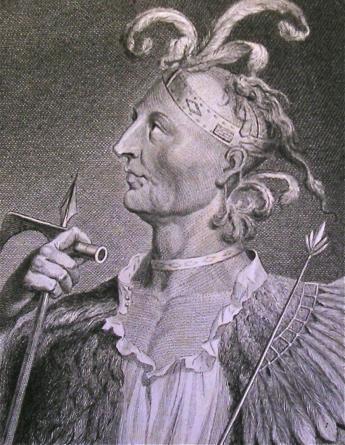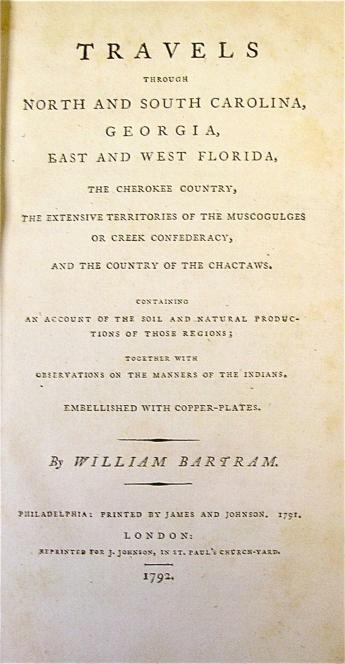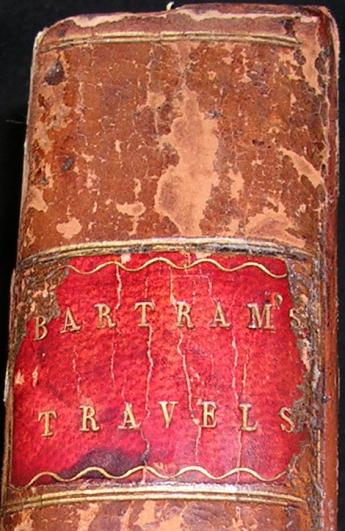Antiquarian Booksellers' Association of America Lighthouse Books, ABAA
Collecting Rare Books and First Editions - William Bartram's Trials and Travels

By Michael Slicker
Everybody has to find their niche in the world and for William Bartram it wasn’t life as a merchant. He was decidedly unsuited for business of any kind. He was a nature lover, and eventually established himself as a botanist. Lucky for us.
The man who gave us one of the best accounts of Florida during the British Period might not ever have gotten to Florida had it not been for his failure as a merchant.
Bartram grew up frolicking in the Botanical Garden his father, John Bartram, established on the Schuylkill River near Philadelphia. He was the only one among John’s seven sons to show much interest in botany. As a young teenager he drew birds and trees and plants, showing the promise as a botanical artist that was realized later.
But in 1756, at the age of about 17, he began to learn the mercantile trade at the side of a merchant in Philadelphia. Still, he kept drawing nature. He spent every spare moment pursuing natural history. His father recognized his abilities and eventually some of William’s drawings ended up being published in England and Holland.
After more than four years in Philadelphia, William was undoubtedly most pleased at the opportunity to go to North Carolina under the watchful eye of his uncle, Col. William Bartram. Young William set up a trading post to earn a living but the wilderness beaconed and he spent considerable time studying his natural surroundings. His business failed.
In 1765, William’s father was appointed royal botanist for King George III. The new position required a trip to British Florida and on the way John stopped in North Carolina to see his brother and son. His business now closed, young William was basically unemployed so he became his father’s assistant and went with him to Florida.
What a trip for the young man. William and his father met knowledgable scientists, cartographers and powerful officials, including James Grant, the British governor of Florida. William drew plants and animals every chance he got. The voyage undoubtedly gave him the experience he would need for later accomplishments.
In 1766, when his father’s business was finished and he was ready to depart for Philadelphia, William decided to stay on in Florida and grow indigo and rice on the banks of the St. Johns River. After all, there were numerous plantations up and down the east coast of Florida doing the same thing more or less successfully.
Not William Bartram. His effort lasted less than a year and was more financially disasterous than anything he had previously tried. He returned to Philadelphia, where he tried to earn a living in agriculture and as a merchant, without a lot of success. In the meantime, he joined Benjamin Franklin in an organization of scientists and scholars dedicated to the pursuit of useful knowledge.
Peter Collinson, an avid gardener and botanist, took interest in young William Bartram and arranged for him to be commissioned to draw mollusks and turtles for wealthy British benefactors, including John Fothergill and Margaret Bentinck, the Duchess of Portland and the richest woman in Britain.
It was Fothergill who proposed and financed William’s journey to explore the wilderness areas of North and South Carolina, Georgia and East and West Florida. The trip began in 1773 and took four years, and eventually resulted in a comprehensive account of the flora and fauna as well native tribes and European settlers in the area at the time.
But not immediately. William was commissioned by his benefactor to ship specimens and drawings to London and he did so. In the meantime, relations between the upstart colonies and Britain deteriorated and the Revolutionary War began. William’s last shipment to Fothergill was in 1776. The following year, William concluded his travels and returned to Philadelphia.
Although several of his journals were published separately shortly after the end of his journey, it would be 15 years before William Bartram’s Travels Through North & South Carolina, Georgia, East & West Florida was finally published in 1791. The following year the British edition appeared. Neither garnered particularly raving reviews at the time, though Bartram’s work inspired poets William Wordsworth and Samuel Taylor Coleridge. A copy of the British edition is in the collection of rare and unusual books at Lighthouse Books, ABAA.
In later generations, naturalists came to value Bartram’s detailed descriptions of the flora and fauna of the southeastern region of the country. And virtually no one cares that he was a dud as a businessman.
(Posted on the Lighthouse Books Blog, presented here by permission of the author.)
Are you collecting rare books by William Bartram?


